Sensitivity Analysis for Linear Regression Models
Sensitivity analysis helps us examine how sensitive a result is against the possibility of unobserved confounding. The current method only supports linear regression estimator. The partial R^2 of treatment with outcome shows how strongly confounders explaining all the residual outcome variation would have to be associated with the treatment to eliminate the estimated effect. The robustness value measures the minimum strength of association unobserved confounding should have with both treatment and outcome in order to change the conclusions. Robustness value close to 1 means the treatment effect can handle strong confounders explaining almost all residual variation of the treatment and the outcome. Robustness value close to 0 means that even very weak confounders can also change the results. Benchmarking examines the sensitivity of causal inferences to plausible strengths of the omitted confounders. This method is based on https://carloscinelli.com/files/Cinelli%20and%20Hazlett%20(2020)%20-%20Making%20Sense%20of%20Sensitivity.pdf
Step 1: Load required packages
[1]:
import os, sys
sys.path.append(os.path.abspath("../../../"))
import dowhy
from dowhy import CausalModel
import pandas as pd
import numpy as np
import dowhy.datasets
# Config dict to set the logging level
import logging.config
DEFAULT_LOGGING = {
'version': 1,
'disable_existing_loggers': False,
'loggers': {
'': {
'level': 'ERROR',
},
}
}
logging.config.dictConfig(DEFAULT_LOGGING)
# Disabling warnings output
import warnings
from sklearn.exceptions import DataConversionWarning
#warnings.filterwarnings(action='ignore', category=DataConversionWarning)
Step 2: Load the dataset
We create a dataset with linear relationships between common causes and treatment, and common causes and outcome. Beta is the true causal effect.
[2]:
np.random.seed(100)
data = dowhy.datasets.linear_dataset( beta = 10,
num_common_causes = 7,
num_samples = 500,
num_treatments = 1,
stddev_treatment_noise =10,
stddev_outcome_noise = 5
)
[3]:
model = CausalModel(
data=data["df"],
treatment=data["treatment_name"],
outcome=data["outcome_name"],
graph=data["gml_graph"],
test_significance=None,
)
model.view_model()
from IPython.display import Image, display
display(Image(filename="causal_model.png"))
data['df'].head()
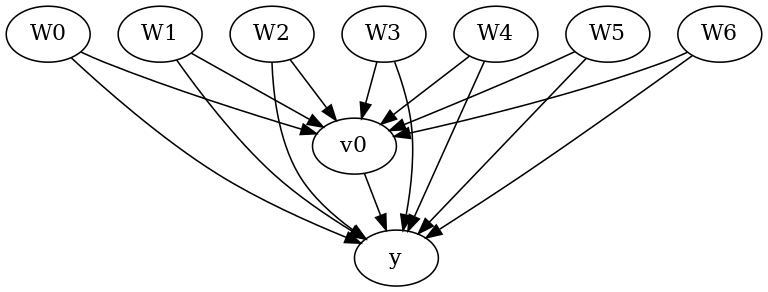
[3]:
| W0 | W1 | W2 | W3 | W4 | W5 | W6 | v0 | y | |
|---|---|---|---|---|---|---|---|---|---|
| 0 | -0.145062 | -0.235286 | 0.784843 | 0.869131 | -1.567724 | -1.290234 | 0.116096 | True | 1.386517 |
| 1 | -0.228109 | -0.020264 | -0.589792 | 0.188139 | -2.649265 | -1.764439 | -0.167236 | False | -16.159402 |
| 2 | 0.868298 | -1.097642 | -0.109792 | 0.487635 | -1.861375 | -0.527930 | -0.066542 | False | -0.702560 |
| 3 | -0.017115 | 1.123918 | 0.346060 | 1.845425 | 0.848049 | 0.778865 | 0.596496 | True | 27.714465 |
| 4 | -0.757347 | -1.426205 | -0.457063 | 1.528053 | -2.681410 | 0.394312 | -0.687839 | False | -20.082633 |
Step 3: Create Causal Model
Remove one of the common causes to simulate unobserved confounding
[4]:
data["df"] = data["df"].drop("W4", axis = 1)
graph_str = 'graph[directed 1node[ id "y" label "y"]node[ id "W0" label "W0"] node[ id "W1" label "W1"] node[ id "W2" label "W2"] node[ id "W3" label "W3"] node[ id "W5" label "W5"] node[ id "W6" label "W6"]node[ id "v0" label "v0"]edge[source "v0" target "y"]edge[ source "W0" target "v0"] edge[ source "W1" target "v0"] edge[ source "W2" target "v0"] edge[ source "W3" target "v0"] edge[ source "W5" target "v0"] edge[ source "W6" target "v0"]edge[ source "W0" target "y"] edge[ source "W1" target "y"] edge[ source "W2" target "y"] edge[ source "W3" target "y"] edge[ source "W5" target "y"] edge[ source "W6" target "y"]]'
model = CausalModel(
data=data["df"],
treatment=data["treatment_name"],
outcome=data["outcome_name"],
graph=graph_str,
test_significance=None,
)
model.view_model()
from IPython.display import Image, display
display(Image(filename="causal_model.png"))
data['df'].head()

[4]:
| W0 | W1 | W2 | W3 | W5 | W6 | v0 | y | |
|---|---|---|---|---|---|---|---|---|
| 0 | -0.145062 | -0.235286 | 0.784843 | 0.869131 | -1.290234 | 0.116096 | True | 1.386517 |
| 1 | -0.228109 | -0.020264 | -0.589792 | 0.188139 | -1.764439 | -0.167236 | False | -16.159402 |
| 2 | 0.868298 | -1.097642 | -0.109792 | 0.487635 | -0.527930 | -0.066542 | False | -0.702560 |
| 3 | -0.017115 | 1.123918 | 0.346060 | 1.845425 | 0.778865 | 0.596496 | True | 27.714465 |
| 4 | -0.757347 | -1.426205 | -0.457063 | 1.528053 | 0.394312 | -0.687839 | False | -20.082633 |
Step 4: Identification
[5]:
identified_estimand = model.identify_effect(proceed_when_unidentifiable=True)
print(identified_estimand)
Estimand type: nonparametric-ate
### Estimand : 1
Estimand name: backdoor
Estimand expression:
d
─────(E[y|W1,W2,W5,W3,W6,W0])
d[v₀]
Estimand assumption 1, Unconfoundedness: If U→{v0} and U→y then P(y|v0,W1,W2,W5,W3,W6,W0,U) = P(y|v0,W1,W2,W5,W3,W6,W0)
### Estimand : 2
Estimand name: iv
No such variable(s) found!
### Estimand : 3
Estimand name: frontdoor
No such variable(s) found!
Step 5: Estimation
Currently only Linear Regression estimator is supported for Linear Sensitivity Analysis
[6]:
estimate = model.estimate_effect(identified_estimand,method_name="backdoor.linear_regression")
print(estimate)
*** Causal Estimate ***
## Identified estimand
Estimand type: nonparametric-ate
### Estimand : 1
Estimand name: backdoor
Estimand expression:
d
─────(E[y|W1,W2,W5,W3,W6,W0])
d[v₀]
Estimand assumption 1, Unconfoundedness: If U→{v0} and U→y then P(y|v0,W1,W2,W5,W3,W6,W0,U) = P(y|v0,W1,W2,W5,W3,W6,W0)
## Realized estimand
b: y~v0+W1+W2+W5+W3+W6+W0
Target units: ate
## Estimate
Mean value: 10.697677486880918
Step 6: Refutation and Sensitivity Analysis
identified_estimand: An instance of the identifiedEstimand class that provides the information with respect to which causal pathways are employed when the treatment effects the outcome estimate: An instance of CausalEstimate class. The estimate obtained from the estimator for the original data. method_name: Refutation method name simulated_method_name: “linear-partial-R2” for Linear Sensitivity Analysis benchmark_common_causes: Name of the covariates used to bound the strengths of unobserved confounder percent_change_estimate: It is the percentage of reduction of treatment estimate that could alter the results (default = 1) if percent_change_estimate = 1, the robustness value describes the strength of association of confounders with treatment and outcome in order to reduce the estimate by 100% i.e bring it down to 0. confounder_increases_estimate: confounder_increases_estimate = True implies that confounder increases the absolute value of estimate and vice versa. Default is confounder_increases_estimate = False i.e. the considered confounders pull estimate towards zero effect_fraction_on_treatment: Strength of association between unobserved confounder and treatment compared to benchmark covariate effect_fraction_on_outcome: Strength of association between unobserved confounder and outcome compared to benchmark covariate null_hypothesis_effect: assumed effect under the null hypothesis (default = 0) plot_estimate: Generate contour plot for estimate while performing sensitivity analysis. (default = True). To override the setting, set plot_estimate = False.
[7]:
refute = model.refute_estimate(identified_estimand, estimate ,
method_name = "add_unobserved_common_cause",
simulated_method_name = "linear-partial-R2",
benchmark_common_causes = ["W3"],
effect_fraction_on_treatment = [ 1,2,3]
)
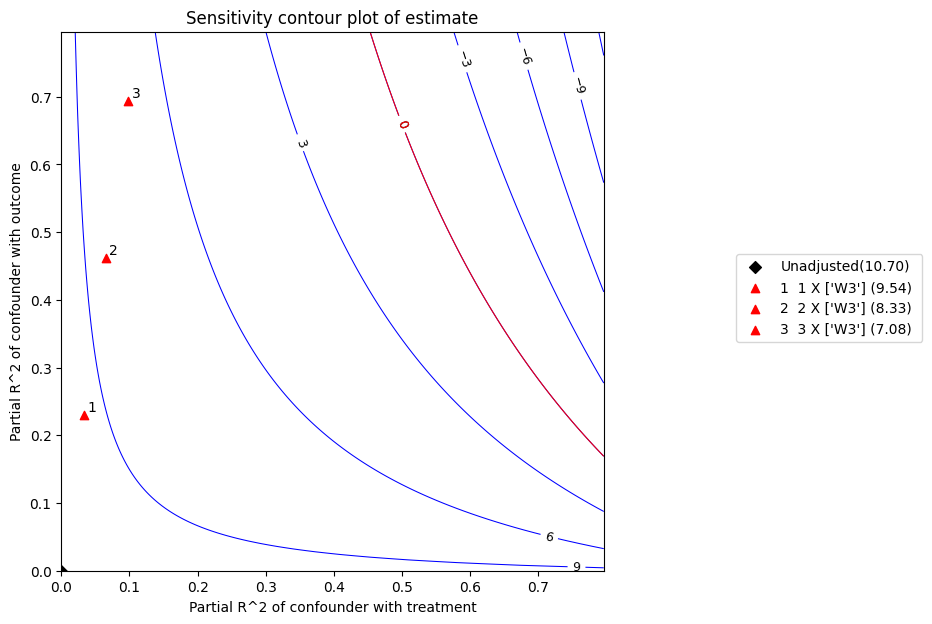
The x axis shows hypothetical partial R2 values of unobserved confounder(s) with the treatment. The y axis shows hypothetical partial R2 of unobserved confounder(s) with the outcome. The contour levels represent adjusted t-values or estimates for unobserved confounders with hypothetical partialR2 values when these would be included in full regression model. The red line is the critical threshold: confounders with such strength or stronger are sufficient to invalidate the research conclusions.
[8]:
refute.stats
[8]:
{'estimate': 10.697677486880917,
'standard_error': 0.5938735661282948,
'degree of freedom': 492,
't_statistic': 18.013392238727615,
'r2yt_w': 0.39741498372666795,
'partial_f2': 0.6595168698094559,
'robustness_value': 0.5467445572181008,
'robustness_value_alpha': 0.5076289101030925}
[9]:
refute.benchmarking_results
[9]:
| r2tu_w | r2yu_tw | bias_adjusted_estimate | bias_adjusted_se | bias_adjusted_t | bias_adjusted_lower_CI | bias_adjusted_upper_CI | |
|---|---|---|---|---|---|---|---|
| 0 | 0.032677 | 0.230238 | 9.535964 | 0.530308 | 17.981928 | 8.494016 | 10.577912 |
| 1 | 0.065354 | 0.461490 | 8.331381 | 0.451241 | 18.463243 | 7.444783 | 9.217979 |
| 2 | 0.098031 | 0.693855 | 7.080284 | 0.346341 | 20.443123 | 6.399795 | 7.760773 |
Parameter List for plot function
plot_type: “estimate” or “t-value” critical_value: special reference value of the estimate or t-value that will be highlighted in the plot x_limit: plot’s maximum x_axis value (default = 0.8) y_limit: plot’s minimum y_axis value (default = 0.8) num_points_per_contour: number of points to calculate and plot each contour line (default = 200) plot_size: tuple denoting the size of the plot (default = (7,7)) contours_color: color of contour line (default = blue) String or array. If array, lines will be plotted with the specific color in ascending order. critical_contour_color: color of threshold line (default = red) label_fontsize: fontsize for labelling contours (default = 9) contour_linewidths: linewidths for contours (default = 0.75) contour_linestyles: linestyles for contours (default = “solid”) See : https://matplotlib.org/3.5.0/gallery/lines_bars_and_markers/linestyles.html contours_label_color: color of contour line label (default = black) critical_label_color: color of threshold line label (default = red) unadjusted_estimate_marker: marker type for unadjusted estimate in the plot (default = ‘D’) See: https://matplotlib.org/stable/api/markers_api.html unadjusted_estimate_color: marker color for unadjusted estimate in the plot (default = “black”) adjusted_estimate_marker: marker type for bias adjusted estimates in the plot (default = ‘^’)adjusted_estimate_color: marker color for bias adjusted estimates in the plot (default = “red”) legend_position:tuple denoting the position of the legend (default = (1.6, 0.6))
[10]:
refute.plot(plot_type = 't-value')
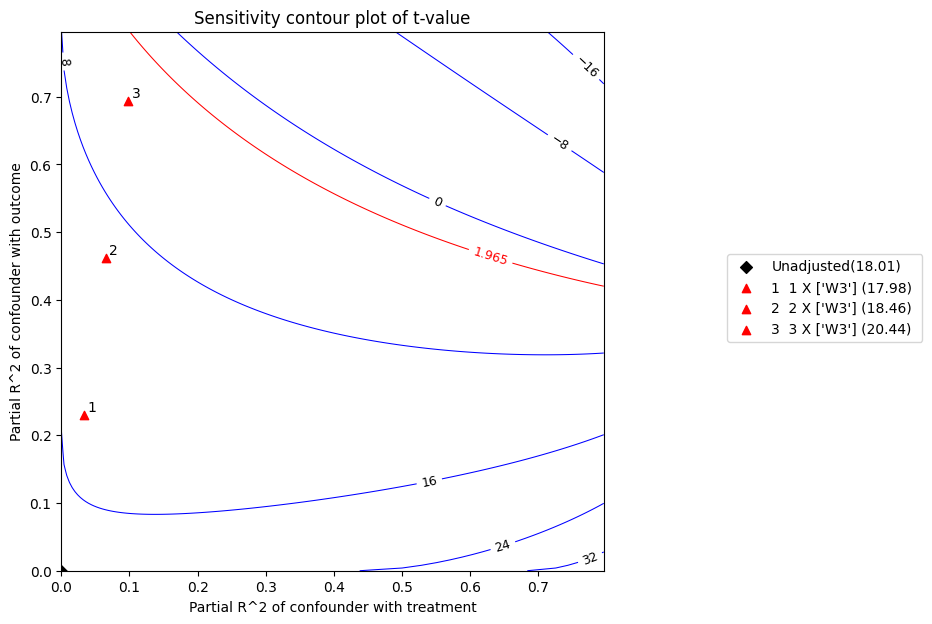
The t statistic is the coefficient divided by its standard error. The higher the t-value, the greater the evidence to reject the null hypothesis. According to the above plot,at 5% significance level, the null hypothesis of zero effect would be rejected given the above confounders.
[11]:
print(refute)
Sensitivity Analysis to Unobserved Confounding using R^2 paramterization
Unadjusted Estimates of Treatment ['v0'] :
Coefficient Estimate : 10.697677486880917
Degree of Freedom : 492
Standard Error : 0.5938735661282948
t-value : 18.013392238727615
F^2 value : 0.6595168698094559
Sensitivity Statistics :
Partial R2 of treatment with outcome : 0.39741498372666795
Robustness Value : 0.5467445572181008
Interpretation of results :
Any confounder explaining less than 54.67% percent of the residual variance of both the treatment and the outcome would not be strong enough to explain away the observed effect i.e bring down the estimate to 0
For a significance level of 5.0%, any confounder explaining more than 50.76% percent of the residual variance of both the treatment and the outcome would be strong enough to make the estimated effect not 'statistically significant'
If confounders explained 100% of the residual variance of the outcome, they would need to explain at least 39.74% of the residual variance of the treatment to bring down the estimated effect to 0
Sensitivity Analysis for dataset with no confounders
We now run the sensitivity analysis for the same dataset but without dropping any variable. We get a robustness value goes from 0.55 to 0.95 which means that treatment effect can handle strong confounders explaining almost all residual variation of the treatment and the outcome.
[12]:
np.random.seed(100)
data = dowhy.datasets.linear_dataset( beta = 10,
num_common_causes = 7,
num_samples = 500,
num_treatments = 1,
stddev_treatment_noise=10,
stddev_outcome_noise = 1
)
[13]:
model = CausalModel(
data=data["df"],
treatment=data["treatment_name"],
outcome=data["outcome_name"],
graph=data["gml_graph"],
test_significance=None,
)
model.view_model()
from IPython.display import Image, display
display(Image(filename="causal_model.png"))
data['df'].head()
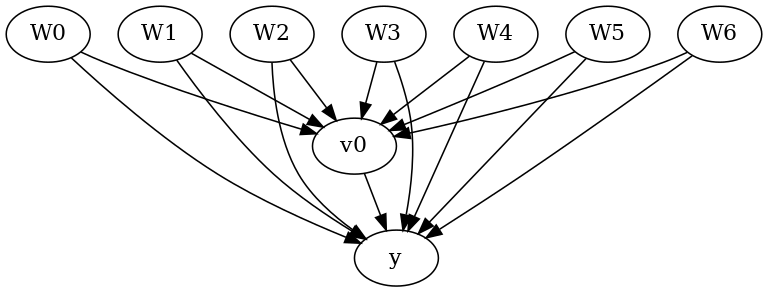
[13]:
| W0 | W1 | W2 | W3 | W4 | W5 | W6 | v0 | y | |
|---|---|---|---|---|---|---|---|---|---|
| 0 | -0.145062 | -0.235286 | 0.784843 | 0.869131 | -1.567724 | -1.290234 | 0.116096 | True | 6.311809 |
| 1 | -0.228109 | -0.020264 | -0.589792 | 0.188139 | -2.649265 | -1.764439 | -0.167236 | False | -12.274406 |
| 2 | 0.868298 | -1.097642 | -0.109792 | 0.487635 | -1.861375 | -0.527930 | -0.066542 | False | -6.487561 |
| 3 | -0.017115 | 1.123918 | 0.346060 | 1.845425 | 0.848049 | 0.778865 | 0.596496 | True | 24.653183 |
| 4 | -0.757347 | -1.426205 | -0.457063 | 1.528053 | -2.681410 | 0.394312 | -0.687839 | False | -13.770396 |
[14]:
identified_estimand = model.identify_effect(proceed_when_unidentifiable=True)
print(identified_estimand)
Estimand type: nonparametric-ate
### Estimand : 1
Estimand name: backdoor
Estimand expression:
d
─────(E[y|W1,W2,W5,W4,W3,W6,W0])
d[v₀]
Estimand assumption 1, Unconfoundedness: If U→{v0} and U→y then P(y|v0,W1,W2,W5,W4,W3,W6,W0,U) = P(y|v0,W1,W2,W5,W4,W3,W6,W0)
### Estimand : 2
Estimand name: iv
No such variable(s) found!
### Estimand : 3
Estimand name: frontdoor
No such variable(s) found!
[15]:
estimate = model.estimate_effect(identified_estimand,method_name="backdoor.linear_regression")
print(estimate)
*** Causal Estimate ***
## Identified estimand
Estimand type: nonparametric-ate
### Estimand : 1
Estimand name: backdoor
Estimand expression:
d
─────(E[y|W1,W2,W5,W4,W3,W6,W0])
d[v₀]
Estimand assumption 1, Unconfoundedness: If U→{v0} and U→y then P(y|v0,W1,W2,W5,W4,W3,W6,W0,U) = P(y|v0,W1,W2,W5,W4,W3,W6,W0)
## Realized estimand
b: y~v0+W1+W2+W5+W4+W3+W6+W0
Target units: ate
## Estimate
Mean value: 10.081924375588311
[16]:
refute = model.refute_estimate(identified_estimand, estimate ,
method_name = "add_unobserved_common_cause",
simulated_method_name = "linear-partial-R2",
benchmark_common_causes = ["W3"],
effect_fraction_on_treatment = [ 1,2,3])
/__w/dowhy/dowhy/dowhy/causal_refuters/linear_sensitivity_analyzer.py:200: RuntimeWarning: divide by zero encountered in divide
bias_adjusted_t = (bias_adjusted_estimate - self.null_hypothesis_effect) / bias_adjusted_se
/__w/dowhy/dowhy/dowhy/causal_refuters/linear_sensitivity_analyzer.py:202: RuntimeWarning: invalid value encountered in divide
bias_adjusted_partial_r2 = bias_adjusted_t**2 / (
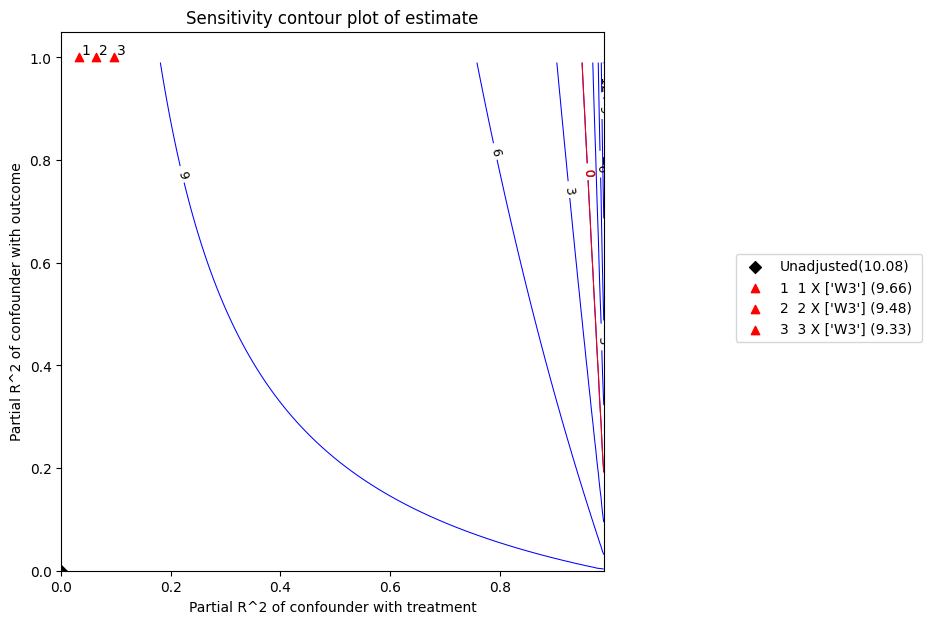
[17]:
refute.plot(plot_type = 't-value')
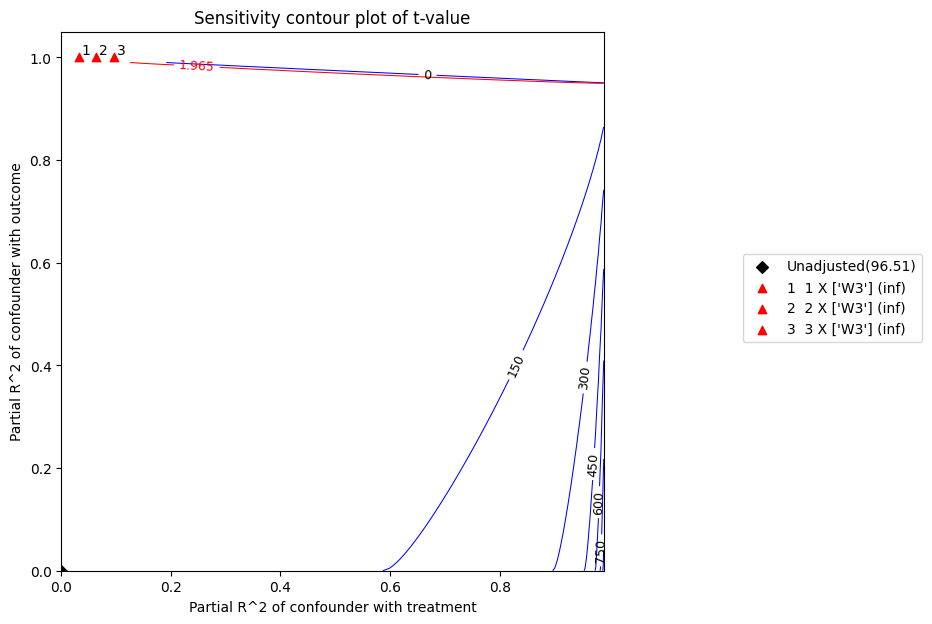
[18]:
print(refute)
Sensitivity Analysis to Unobserved Confounding using R^2 paramterization
Unadjusted Estimates of Treatment ['v0'] :
Coefficient Estimate : 10.081924375588311
Degree of Freedom : 491
Standard Error : 0.10446229543424758
t-value : 96.51256784735547
F^2 value : 18.970826379817503
Sensitivity Statistics :
Partial R2 of treatment with outcome : 0.9499269594066173
Robustness Value : 0.9522057801012398
Interpretation of results :
Any confounder explaining less than 95.22% percent of the residual variance of both the treatment and the outcome would not be strong enough to explain away the observed effect i.e bring down the estimate to 0
For a significance level of 5.0%, any confounder explaining more than 95.04% percent of the residual variance of both the treatment and the outcome would be strong enough to make the estimated effect not 'statistically significant'
If confounders explained 100% of the residual variance of the outcome, they would need to explain at least 94.99% of the residual variance of the treatment to bring down the estimated effect to 0
[19]:
refute.stats
[19]:
{'estimate': 10.081924375588311,
'standard_error': 0.10446229543424758,
'degree of freedom': 491,
't_statistic': 96.51256784735547,
'r2yt_w': 0.9499269594066173,
'partial_f2': 18.970826379817503,
'robustness_value': 0.9522057801012398,
'robustness_value_alpha': 0.950386691319526}
[20]:
refute.benchmarking_results
[20]:
| r2tu_w | r2yu_tw | bias_adjusted_estimate | bias_adjusted_se | bias_adjusted_t | bias_adjusted_lower_CI | bias_adjusted_upper_CI | |
|---|---|---|---|---|---|---|---|
| 0 | 0.031976 | 1.0 | 9.661229 | 0.0 | inf | 9.661229 | 9.661229 |
| 1 | 0.063952 | 1.0 | 9.476895 | 0.0 | inf | 9.476895 | 9.476895 |
| 2 | 0.095927 | 1.0 | 9.327927 | 0.0 | inf | 9.327927 | 9.327927 |
[ ]:
[ ]: